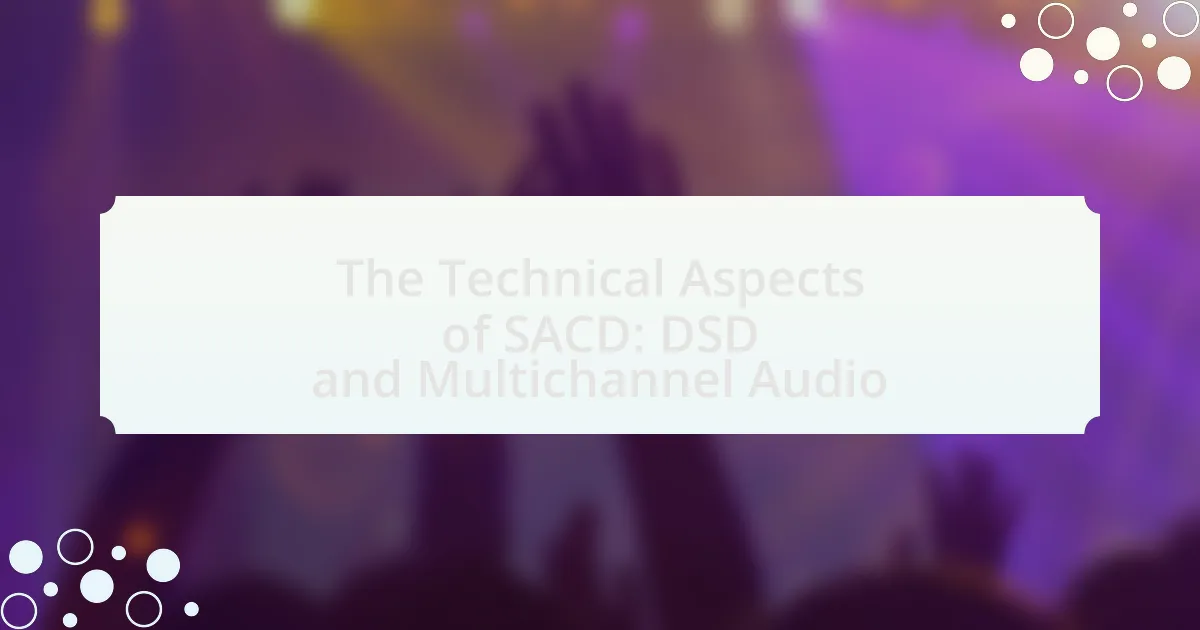The article focuses on the technical aspects of Super Audio CD (SACD), emphasizing its use of Direct Stream Digital (DSD) encoding and multichannel audio capabilities. It explains how DSD technology, with a sampling rate of 2.8224 MHz, allows for high-resolution audio reproduction, surpassing traditional CD formats. The article also details the advantages of multichannel audio in SACD, which enhances the listening experience by providing immersive sound through configurations like 5.1 and 7.1 surround sound. Additionally, it addresses the practical implications of SACD technology for consumers, including necessary equipment for optimal playback and troubleshooting tips for common issues.
What are the Technical Aspects of SACD?

The technical aspects of SACD (Super Audio CD) primarily involve its use of Direct Stream Digital (DSD) encoding and support for multichannel audio. DSD is a form of digital audio encoding that uses a 1-bit sigma-delta modulation process, allowing for high-resolution audio reproduction with a sampling rate of 2.8224 MHz, which is significantly higher than the standard CD’s 44.1 kHz. This high sampling rate enables SACD to capture a wider frequency range and dynamic range, resulting in superior sound quality.
Additionally, SACD supports multichannel audio formats, typically offering 5.1 surround sound, which enhances the listening experience by providing a more immersive soundstage. The combination of DSD encoding and multichannel capabilities makes SACD a preferred choice for audiophiles seeking high-fidelity audio experiences.
How does SACD differ from traditional audio formats?
SACD, or Super Audio CD, differs from traditional audio formats primarily through its use of Direct Stream Digital (DSD) technology, which allows for higher resolution audio. Unlike standard CDs that utilize Pulse Code Modulation (PCM) at a maximum of 16-bit/44.1 kHz, SACD employs a 1-bit DSD encoding at 2.8224 MHz, resulting in a more detailed and nuanced sound reproduction. Additionally, SACD supports multichannel audio, enabling a surround sound experience, whereas traditional formats typically focus on stereo sound. This capability enhances the listening experience by providing a more immersive audio environment.
What are the key features that define SACD technology?
SACD technology is defined by its use of Direct Stream Digital (DSD) encoding, which allows for high-resolution audio playback. This encoding method captures audio at a sampling rate of 2.8224 MHz, significantly higher than standard CDs, resulting in greater detail and fidelity. Additionally, SACD supports multichannel audio, enabling a surround sound experience with up to six channels, enhancing the immersive quality of music. The physical format of SACDs includes a hybrid layer, allowing compatibility with standard CD players while providing the enhanced audio experience on SACD-compatible devices. These features collectively contribute to SACD’s reputation for superior sound quality compared to traditional audio formats.
Why is SACD considered a high-resolution audio format?
SACD is considered a high-resolution audio format because it utilizes Direct Stream Digital (DSD) technology, which offers a sampling rate of 2.8224 MHz, significantly higher than the standard CD’s 44.1 kHz. This higher sampling rate allows for greater audio detail and a more accurate representation of sound, resulting in improved fidelity. Additionally, SACD supports multichannel audio, enabling immersive sound experiences that further enhance its high-resolution capabilities.
What role does DSD play in SACD?
DSD, or Direct Stream Digital, serves as the primary audio encoding format for Super Audio CD (SACD). This format utilizes a 1-bit delta-sigma modulation technique, which allows for high-resolution audio reproduction, capturing frequencies up to 100 kHz. The implementation of DSD in SACD enables a more accurate representation of sound compared to traditional PCM formats, as it reduces quantization noise and enhances dynamic range. This is supported by the fact that SACD can deliver audio at a sampling rate of 2.8224 MHz, significantly higher than standard CDs, which operate at 44.1 kHz.
What is DSD and how does it work?
DSD, or Direct Stream Digital, is a digital audio encoding format that uses a 1-bit delta-sigma modulation technique to represent audio signals. This method captures audio at a high sampling rate, typically 2.8 MHz for standard DSD, which allows for a more accurate representation of sound compared to traditional PCM formats. DSD works by converting the audio waveform into a series of 1s and 0s, where the 1-bit stream represents changes in amplitude over time, effectively capturing the nuances of the original sound. This high-resolution format is utilized in Super Audio CDs (SACDs) and is known for its ability to reproduce audio with a high level of detail and dynamic range, making it a preferred choice for audiophiles.
How does DSD compare to PCM in audio quality?
DSD generally offers superior audio quality compared to PCM due to its higher sampling rates and bit depth, which allow for more detailed sound reproduction. DSD, or Direct Stream Digital, uses a 1-bit delta-sigma modulation process that captures audio at rates up to 2.8 MHz or higher, resulting in a more accurate representation of the original sound wave. In contrast, PCM, or Pulse Code Modulation, typically operates at lower sampling rates and bit depths, such as 44.1 kHz/16-bit, which can lead to quantization errors and a loss of detail in the audio signal. Studies have shown that listeners often perceive DSD recordings as having a more natural and immersive sound quality, particularly in high-frequency ranges, which is supported by research indicating that higher sampling rates can improve the fidelity of audio playback.
What is multichannel audio in the context of SACD?
Multichannel audio in the context of SACD refers to the capability of Super Audio CD to deliver sound through multiple audio channels, typically five or more, creating an immersive listening experience. This format utilizes Direct Stream Digital (DSD) technology, which allows for high-resolution audio playback across various channels, enhancing spatial sound representation. The SACD standard supports both stereo and multichannel formats, with multichannel audio providing a richer and more dynamic soundstage, as evidenced by its adoption in high-fidelity music recordings and film soundtracks.
How does multichannel audio enhance the listening experience?
Multichannel audio enhances the listening experience by providing a more immersive sound environment that replicates the spatial characteristics of live performances. This format allows sound to come from multiple directions, creating a three-dimensional audio landscape that engages listeners more deeply than traditional stereo sound. Research indicates that multichannel audio can improve listener engagement and emotional response, as it closely mimics how humans naturally perceive sound in their surroundings. For instance, studies have shown that listeners report a heightened sense of presence and realism when experiencing multichannel audio systems compared to two-channel setups.
What are the different multichannel configurations available in SACD?
The different multichannel configurations available in SACD include 5.1 surround sound and 7.1 surround sound. SACD supports these configurations by utilizing Direct Stream Digital (DSD) encoding, which allows for high-resolution audio playback across multiple channels. The 5.1 configuration typically consists of five full-range channels (left, center, right, left surround, right surround) and one low-frequency effects channel, while the 7.1 configuration adds two additional rear surround channels for enhanced spatial audio experience. This multichannel capability is a key feature of SACD, enabling immersive listening experiences in home theater systems.
How does DSD technology function within SACD?

DSD technology functions within SACD by utilizing a 1-bit delta-sigma modulation process to encode audio signals. This method captures audio at a high sampling rate, typically 2.8224 MHz, which is significantly higher than standard CD audio, allowing for greater detail and dynamic range in the sound reproduction. The 1-bit format of DSD enables a more accurate representation of the audio waveform, resulting in a smoother and more natural sound. This high-resolution audio format is particularly effective for multichannel audio, as it can support up to six channels of audio, providing an immersive listening experience.
What are the advantages of using DSD for audio recording?
The advantages of using DSD (Direct Stream Digital) for audio recording include its high-resolution audio quality and efficient data compression. DSD captures audio at a sampling rate of 2.8224 MHz or higher, which allows for a more accurate representation of sound compared to traditional PCM (Pulse Code Modulation) formats. This high sampling rate results in a smoother waveform and reduced quantization noise, leading to a more natural sound reproduction. Additionally, DSD’s 1-bit encoding simplifies the digital signal processing, which can enhance playback performance and reduce artifacts. These characteristics make DSD particularly appealing for audiophiles and professionals seeking superior sound fidelity in recordings.
How does DSD affect dynamic range and frequency response?
DSD, or Direct Stream Digital, positively affects dynamic range and frequency response by providing a higher bit depth and sampling rate compared to traditional PCM formats. This results in a dynamic range that can exceed 120 dB, allowing for more nuanced sound reproduction, particularly in quiet passages. Additionally, DSD’s 1-bit encoding captures high-frequency information more effectively, leading to a frequency response that can extend beyond the audible range, thus preserving the integrity of the audio signal. Studies have shown that DSD’s unique modulation technique reduces quantization noise, further enhancing both dynamic range and frequency response in high-resolution audio playback.
What challenges are associated with DSD recording and playback?
DSD recording and playback face several challenges, primarily related to data management and compatibility. The high data rate of DSD, which uses a 1-bit signal at a sampling frequency of 2.8224 MHz or higher, can lead to difficulties in storage and processing, requiring significant bandwidth and storage capacity. Additionally, DSD’s unique format is not universally supported by all audio equipment, which can result in compatibility issues when attempting to play DSD files on standard devices. Furthermore, the conversion of DSD to PCM for editing or playback on non-DSD systems can introduce artifacts and degrade audio quality, complicating the workflow for audio engineers. These challenges highlight the technical limitations and considerations necessary for effective DSD recording and playback.
How is DSD implemented in SACD production?
DSD, or Direct Stream Digital, is implemented in SACD (Super Audio CD) production through a one-bit delta-sigma modulation process that captures audio signals at a high sampling rate of 2.8224 MHz. This method allows for the representation of audio with a high dynamic range and low noise, making it suitable for high-fidelity sound reproduction. The DSD format encodes audio data in a way that preserves the nuances of the original sound, which is crucial for SACD’s goal of delivering superior audio quality compared to traditional CD formats.
What are the steps involved in creating a DSD recording?
The steps involved in creating a DSD recording include capturing audio using a DSD-capable microphone, converting the audio signal into a DSD format through a DSD converter, and then storing the DSD data on a suitable medium. Initially, high-quality microphones are used to capture sound, ensuring fidelity. The captured analog signal is then converted to DSD using a specialized A/D converter that employs a 1-bit delta-sigma modulation process, which is essential for achieving the high sampling rates characteristic of DSD. Finally, the DSD data is recorded onto a digital medium, such as a hard drive or optical disc, for playback. This process is validated by the fact that DSD recordings are known for their high resolution and audio quality, making them a preferred choice in high-fidelity audio applications.
How do mastering techniques differ for DSD compared to other formats?
Mastering techniques for Direct Stream Digital (DSD) differ from other formats primarily due to DSD’s unique 1-bit encoding and high sampling rates, which require specific processing methods. Unlike Pulse Code Modulation (PCM) formats, where multiple bits represent each sample, DSD’s single-bit stream necessitates a different approach to equalization and dynamic range control to avoid distortion and maintain audio fidelity.
For instance, traditional equalization techniques used in PCM can introduce phase issues in DSD, so mastering engineers often employ specialized DSD-compatible tools that preserve the integrity of the audio signal. Additionally, DSD’s high sampling rates, typically 2.8 MHz or 5.6 MHz, allow for a more nuanced representation of sound, which influences the choice of mastering techniques to enhance the overall listening experience without compromising quality.
What are the practical implications of SACD’s technical aspects?

The practical implications of SACD’s technical aspects include enhanced audio quality and the ability to deliver multichannel sound. SACD utilizes Direct Stream Digital (DSD) encoding, which captures audio at a higher resolution than standard CDs, resulting in clearer and more detailed sound reproduction. This high-resolution audio format supports multichannel audio, allowing for immersive listening experiences that traditional stereo formats cannot provide. The implementation of SACD in home audio systems can lead to a significant improvement in sound fidelity, making it particularly appealing to audiophiles and music enthusiasts seeking superior audio experiences.
How can consumers benefit from SACD technology?
Consumers can benefit from SACD technology through enhanced audio quality and immersive sound experiences. SACD, or Super Audio CD, utilizes Direct Stream Digital (DSD) encoding, which provides a higher resolution audio format compared to standard CDs, resulting in clearer and more detailed sound reproduction. Additionally, SACD supports multichannel audio, allowing consumers to experience music in a surround sound format, which creates a more engaging listening experience. Studies have shown that listeners often perceive SACD recordings as more dynamic and lifelike, further validating the advantages of this technology in delivering superior sound quality.
What equipment is necessary to fully experience SACD audio?
To fully experience SACD audio, a dedicated SACD player is necessary, as it is designed to decode the Super Audio CD format. Additionally, a compatible audio system that supports high-resolution audio playback, including multichannel audio capabilities, is essential for optimal sound quality. Many SACD players also offer HDMI outputs, which can connect to modern AV receivers that support SACD playback, ensuring the best audio experience.
How can users optimize their SACD playback setup?
To optimize SACD playback setup, users should ensure they have a compatible SACD player that supports DSD (Direct Stream Digital) audio format. This is crucial because SACDs utilize DSD for high-resolution audio, which provides superior sound quality compared to standard CDs. Additionally, users should connect their SACD player to a high-quality AV receiver or processor that can decode DSD signals, as this will enhance the multichannel audio experience. Using high-quality interconnects and speaker cables can further improve audio fidelity. Finally, positioning speakers correctly in the listening environment can significantly impact soundstage and imaging, leading to a more immersive listening experience.
What are common troubleshooting tips for SACD users?
Common troubleshooting tips for SACD users include checking the compatibility of the SACD player with the disc format, ensuring that the audio output settings are correctly configured, and verifying that the connections to the audio system are secure. Users should also inspect the SACD disc for scratches or damage, as this can affect playback quality. Additionally, updating the firmware of the SACD player can resolve performance issues, as manufacturers often release updates to improve functionality and compatibility with various discs.
How can users resolve playback issues with SACD discs?
Users can resolve playback issues with SACD discs by ensuring compatibility with their playback equipment. SACDs require specific players that support the Super Audio CD format, as standard CD players cannot read the high-resolution DSD layer. Additionally, users should check for firmware updates for their SACD players, as manufacturers often release updates to improve compatibility and performance. If playback issues persist, users should inspect the SACD for scratches or dirt, as physical damage can hinder playback. Finally, users can consult the user manual for troubleshooting tips specific to their SACD player model, which may provide further guidance on resolving playback issues.
What maintenance practices can enhance the longevity of SACD equipment?
Regular maintenance practices that can enhance the longevity of SACD equipment include keeping the device clean, ensuring proper ventilation, and using high-quality cables. Cleaning the equipment prevents dust accumulation, which can interfere with performance and lead to overheating. Proper ventilation is crucial as it allows heat dissipation, reducing the risk of thermal damage. Additionally, using high-quality cables minimizes signal degradation, ensuring optimal audio quality and reducing wear on the connectors. These practices are supported by industry standards that emphasize the importance of maintaining audio equipment for optimal performance and longevity.

Leave a Reply